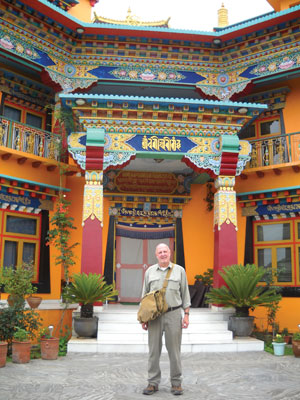Professor volunteers to monks in India
January 1, 2011

For the third year in a row, Central Wyoming College Theater Director Mike Myers spent a majority of his summer vacation volunteering in a faraway land on his own dime.
This year’s experience was different from those he had before teaching in Katmandu, Nepal and Phnom Penh, Cambodia, though in some ways, it was comparable.
In the spring, he connected with a volunteer agency in India, a country he selected because he could find reasonably priced airline tickets and the cost of living was low. He went to Delhi, a city of 14 million, for a one-week orientation, immersing himself in the Hindi language and the Indian culture. It was his understanding that he’d be living with a farmer’s family outside of Jaipur, a city of 3 million located in the country’s scorching hot desert, and would teach English at a public school.
After he made the trip halfway around the world, he was advised that the school was on a summer break. “Okay, where can I go now?” he asked of the country director. Myers told him of his experience of teaching at a monastery in Katmandu two years before, and he was sent on a 14-hour bus ride to a Tibetan monastery in northern India, an isolated area between Pakistan and Tibet. The monastery welcomed the teacher of English.
This time, Myers was going to live among the Buddhist monks at this large monastery and teach students of all different ages. Though he had taught monks at a monastery in the capital of Nepal, Myers lived at a hotel with other volunteers.
This time, he lived in a dormitory with the other monks, and they were kind enough to give him private quarters. Myers also dined with the monks, and lost 17 pounds on the monastery diet.
Breakfast consisted of rice porridge, which is made with leftover rice and hot water with herb flavoring, rice and dall for lunch, which is similar to a lentil soup, and thukpa for dinner, which is a Tibetan noodle soup.
“It was remote, up a winding mountain road high in the Himalayas,” Myers recalled of his first sight of the monastery. Though he was in India, most of the population of the region was Tibetan. When the Dalai Lama was forced to flee Tibet in the late 1950s, India allowed him and his followers to settle in this region. “Almost everyone had escaped Tibet,” Myers said.
The monastery was a “Shedra,” or a place to study Buddhist philosophy. This particualar monastery had a “very large campus,” which included a nunnery, another monastery and several meditation retreats.
“The Tibetan community is extremely religious and are ardent Buddhists,” Myers said. “Almost all families want one of their sons to grow up to be a Buddhist monk.
The youngsters who enter the monastery are “getting prepped” for the monastic life though some enter because it provides education, food and shelter. When the boys turn 16 or 17, they begin to study Buddhist philosophy. “It’s a ten-year program,” Myers said, explaining it is like earning a Ph.D. Once a monk completes ten years of study at the Shedra, some monks continue with further training.
One thing in common among the monks is their desire to learn English. Monks want to travel and they are more likely to be sent to other locations if they speak English.
Myers spent his first few days determining the English skill of his students, who ranged in age from 5 to 35. The 40 students met at the same time in the same room, so Myers divided them into three groups by their abilities, and developed different lesson plans for each group. The class met six days a week.
“Even the littlest kids had some English skills; not a lot, but some,” he said. Myers taught verbs and nouns and had them do worksheets and read materials from the books he brought from home.
His lesson plans became a little more refined when he was able to travel to Dharamsala, the home of the exiled Tibetan government as well as the place where the Dalai Lama settled after his escape from Tibet. There he purchased appropriate books, crayons and drawing paper.
Myers believes he achieved success with his instruction, especially with the adult monks. “I taught them 107 verbs and how to conjugate them in the present, past and future tenses,” he said. “That was a monumental achievement. I had them reading, writing and speaking.”
To maintain some continuity with his instruction, Myers left the next volunteer a letter describing his teaching methods.
The monks, Myers said, are supported by wealthy benefactors from America, China, Hong Kong or Europe though they live the life of poverty.